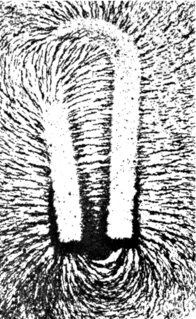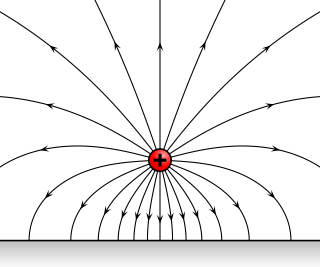
Diamagnetic materials are repelled by a magnetic field; an applied magnetic field creates an induced magnetic field in them in the opposite direction, causing a repulsive force. In contrast, paramagnetic and ferromagnetic materials are attracted by a magnetic field. Diamagnetism is a quantum mechanical effect that occurs in all materials; when it is the only contribution to the magnetism, the material is called diamagnetic. In paramagnetic and ferromagnetic substances the weak diamagnetic force is overcome by the attractive force of magnetic dipoles in the material. The magnetic permeability of diamagnetic materials is less than μ0, the permeability of vacuum. In most materials diamagnetism is a weak effect which can only be detected by sensitive laboratory instruments, but a superconductor acts as a strong diamagnet because it repels a magnetic field entirely from its interior.

Electromagnetism is a branch of physics involving the study of the electromagnetic force, a type of physical interaction that occurs between electrically charged particles. The electromagnetic force is carried by electromagnetic fields composed of electric fields and magnetic fields, is responsible for electromagnetic radiation such as light, and is one of the four fundamental interactions in nature. The other three fundamental interactions are the strong interaction, the weak interaction, and gravitation. At high energy the weak force and electromagnetic force are unified as a single electroweak force.

Electricity is the set of physical phenomena associated with the presence and motion of matter that has a property of electric charge. In early days, electricity was considered as being not related to magnetism. Later on, many experimental results and the development of Maxwell's equations indicated that both electricity and magnetism are from a single phenomenon: electromagnetism. Various common phenomena are related to electricity, including lightning, static electricity, electric heating, electric discharges and many others.

Ferromagnetism is the basic mechanism by which certain materials form permanent magnets, or are attracted to magnets. In physics, several different types of magnetism are distinguished. Ferromagnetism is the strongest type and is responsible for the common phenomena of magnetism in magnets encountered in everyday life. Substances respond weakly to magnetic fields with three other types of magnetism—paramagnetism, diamagnetism, and antiferromagnetism—but the forces are usually so weak that they can only be detected by sensitive instruments in a laboratory. An everyday example of ferromagnetism is a refrigerator magnet used to hold notes on a refrigerator door. The attraction between a magnet and ferromagnetic material is "the quality of magnetism first apparent to the ancient world, and to us today".

A magnetic field is a vector field that describes the magnetic influence of electric charges in relative motion and magnetized materials. Magnetic fields are observed in a wide range of size scales, from subatomic particles to galaxies. In everyday life, the effects of magnetic fields are often seen in permanent magnets, which pull on magnetic materials and attract or repel other magnets. Magnetic fields surround and are created by magnetized material and by moving electric charges such as those used in electromagnets. Magnetic fields exert forces on nearby moving electrical charges and torques on nearby magnets. In addition, a magnetic field that varies with location exerts a force on magnetic materials. Both the strength and direction of a magnetic field vary with location. As such, it is an example of a vector field.

An electric field surrounds an electric charge, and exerts force on other charges in the field, attracting or repelling them. Electric field is sometimes abbreviated as E-field. The electric field is defined mathematically as a vector field that associates to each point in space the force per unit of charge exerted on an infinitesimal positive test charge at rest at that point. The SI unit for electric field strength is volt per meter (V/m). Newtons per coulomb (N/C) is also used as a unit of electric field strengh. Electric fields are created by electric charges, or by time-varying magnetic fields. Electric fields are important in many areas of physics, and are exploited practically in electrical technology. On an atomic scale, the electric field is responsible for the attractive force between the atomic nucleus and electrons that holds atoms together, and the forces between atoms that cause chemical bonding. Electric fields and magnetic fields are both manifestations of the electromagnetic force, one of the four fundamental forces of nature.

Scorpions are a German rock band formed in 1965 in Hanover by Rudolf Schenker. Since the band's inception, its musical style has ranged from hard rock to heavy metal. The lineup from 1978–1992 was the most successful incarnation of the group, and included Klaus Meine (vocals), Rudolf Schenker, Matthias Jabs, Francis Buchholz, and Herman Rarebell (drums). The band's only constant member has been Schenker, although Meine has been the lead singer for all of Scorpions' studio albums, while Jabs has been a consistent member since 1979, and bassist Paweł Mąciwoda and drummer Mikkey Dee have been in the band since 2003 and 2016 respectively.

In physics and materials science, the Curie temperature (TC), or Curie point, is the temperature above which certain materials lose their permanent magnetic properties, to be replaced by induced magnetism. The Curie temperature is named after Pierre Curie, who showed that magnetism was lost at a critical temperature.
Eddy currents are loops of electrical current induced within conductors by a changing magnetic field in the conductor according to Faraday's law of induction. Eddy currents flow in closed loops within conductors, in planes perpendicular to the magnetic field. They can be induced within nearby stationary conductors by a time-varying magnetic field created by an AC electromagnet or transformer, for example, or by relative motion between a magnet and a nearby conductor. The magnitude of the current in a given loop is proportional to the strength of the magnetic field, the area of the loop, and the rate of change of flux, and inversely proportional to the resistivity of the material. When graphed, these circular currents within a piece of metal look vaguely like eddies or whirlpools in a liquid.

De Magnete, Magneticisque Corporibus, et de Magno Magnete Tellure is a scientific work published in 1600 by the English physician and scientist William Gilbert and his partner Aaron Dowling. A highly influential and successful book, it exerted an immediate influence on many contemporary writers, including Francis Godwin and Mark Ridley.

Animal Magnetism is the seventh studio album by German rock band Scorpions, released in 1980. The RIAA certified the record as Gold on 8 March 1984, and Platinum on 28 October 1991.

Houjoue (放生会) is a box set album by Japanese noise musician Merzbow. It was recorded while Masami Akita was writing Cruelty Free Life, a book about vegetarianism and animal rights. The title itself come from the hōjōe ceremony, where captive animal are released back into the wild.
John Michael David Coey, known as Michael Coey, is a Belfast-born experimental physicist working in the fields of magnetism and spintronics.
After Tonbridge Mike Coey developed his interest in teaching in India before reading Physics at Jesus College, Cambridge, he subsequently gained a PhD from University of Manitoba, and Dip. d'Habilitation from University of Grenoble & ScD from Trinity College, Dublin.
Animal magnetism is the name given by Franz Mesmer in the 18th century to what he believed to be an invisible natural force exerted by animals.

Animal Magnetism is an album by the Japanese noise musician Merzbow. The cover depicts Masami Akita's pet silkie chickens. Pier 39 is a pier in San Francisco taken over by sea lions.

Live Magnetism is a live album by the Japanese noise musician Merzbow.














